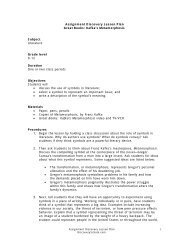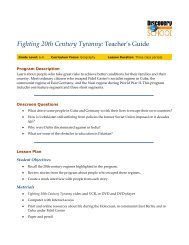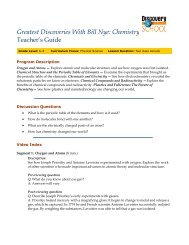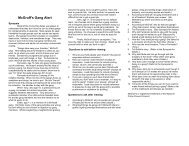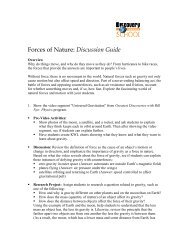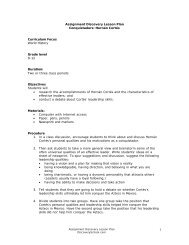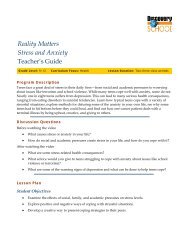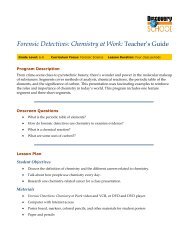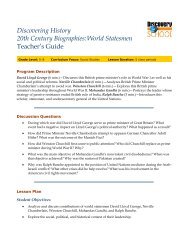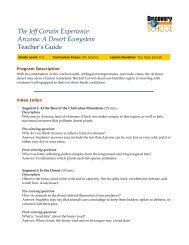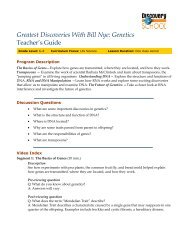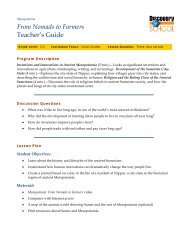Pendemonium: The Posse in Australia - Discovery Education
Pendemonium: The Posse in Australia - Discovery Education
Pendemonium: The Posse in Australia - Discovery Education
Create successful ePaper yourself
Turn your PDF publications into a flip-book with our unique Google optimized e-Paper software.
<strong>Pendemonium</strong><br />
<strong>The</strong> <strong>Posse</strong> <strong>in</strong> <strong>Australia</strong><br />
Teacher’s Guide<br />
Grade Level: 3–5 Curriculum Focus: Language Arts Lesson Duration: One class period<br />
Program Description<br />
Four writ<strong>in</strong>g implements must save the world from the clutches of a permanent marker gone bad. With<br />
his sidekick, Dottie, and his own small army, the evil Dark Marker makes a claim for global dom<strong>in</strong>ation<br />
by steal<strong>in</strong>g punctuation marks from a local newspaper and hid<strong>in</strong>g out <strong>in</strong> <strong>Australia</strong>. Penny the pencil,<br />
Buzz the PDA, Florent<strong>in</strong>a the founta<strong>in</strong> pen, and Arturo the gel pen discover Dark Marker’s plot and<br />
solve clues about grammar rules to save the world from communication chaos.<br />
Discussion Questions<br />
• What is the purpose of punctuation marks when writ<strong>in</strong>g sentences?<br />
• When do you often use a period?<br />
• Where are commas often placed?<br />
• What is the difference between a comma and a period?<br />
Lesson Plan<br />
Student Objectives<br />
• Explore the use of commas and periods.<br />
• Compose a friendly letter.<br />
• Apply rules of punctuation for commas and periods.<br />
• Revise a composition.<br />
Materials<br />
• <strong>Pendemonium</strong>: <strong>The</strong> <strong>Posse</strong> <strong>in</strong> <strong>Australia</strong> video<br />
• Paper and pencils<br />
• United States atlases, one per student<br />
• Pr<strong>in</strong>t resources about punctuation marks
<strong>Pendemonium</strong><br />
<strong>The</strong> <strong>Posse</strong> <strong>in</strong> <strong>Australia</strong><br />
Teacher’s Guide 2<br />
Procedures<br />
1. After view<strong>in</strong>g the video, read aloud Punctuation Takes a Vacation, by Rob<strong>in</strong> Pulver, or a similar<br />
book with a light-hearted look at punctuation.<br />
2. In both the video and book, clues helped characters f<strong>in</strong>d miss<strong>in</strong>g punctuation marks. Expla<strong>in</strong><br />
that <strong>in</strong> this lesson students will also write and solve clues about miss<strong>in</strong>g commas and periods.<br />
3. Encourage students to pretend that all the commas and periods <strong>in</strong> the class are miss<strong>in</strong>g, just like<br />
<strong>in</strong> the video and book. However, each student knows where some of the periods and commas<br />
are and will share clues to help others recover the lost punctuation marks.<br />
4. To f<strong>in</strong>d all of the class’s commas and periods, each student will write a friendly letter to a<br />
partner. <strong>The</strong> letter will conta<strong>in</strong> at least three clues to the mark’s location. But s<strong>in</strong>ce all the<br />
commas and periods are now gone, the students’ letters cannot conta<strong>in</strong> any of these<br />
punctuation marks.<br />
5. Beg<strong>in</strong> the activity by hav<strong>in</strong>g students select a state us<strong>in</strong>g a United States atlas. <strong>The</strong>ir chosen state<br />
is where their commas and periods are located. Students need to note at least three features of<br />
the state to use as clues. Ask students to keep their state a secret. <strong>The</strong>ir partners will have to<br />
determ<strong>in</strong>e the location based on the clues <strong>in</strong> their letters.<br />
6. Next, assign partners. Have students write a friendly letter to their partner. <strong>The</strong>se <strong>in</strong>formal<br />
letters must conta<strong>in</strong> the follow<strong>in</strong>g:<br />
• Salutation or greet<strong>in</strong>g<br />
• Three clues about the state; clues can <strong>in</strong>clude its climate, relative location, important<br />
geographic features such as mounta<strong>in</strong>s, rivers, and lakes, major cities, and famous build<strong>in</strong>gs<br />
or bridges<br />
• One list of three or more items<br />
• One command<br />
• Clos<strong>in</strong>g<br />
7. Rem<strong>in</strong>d students aga<strong>in</strong> that the letters cannot <strong>in</strong>clude any commas or periods.<br />
8. <strong>The</strong>n have partners exchange letters. Ask student volunteers to read their letters aloud. Rem<strong>in</strong>d<br />
students to read without paus<strong>in</strong>g or stopp<strong>in</strong>g.<br />
9. Have students apply their knowledge of the use of commas and periods by revis<strong>in</strong>g their<br />
partners’ letters. Ask students to add the miss<strong>in</strong>g commas and periods.<br />
10. After revis<strong>in</strong>g the letters, students should use the clues to determ<strong>in</strong>e the location of the miss<strong>in</strong>g<br />
punctuation marks. Encourage students to refer to their atlases to confirm their guesses. When<br />
students have solved the clues, allow partners to meet and verify the mystery locations.<br />
11. Br<strong>in</strong>g the class together and ask volunteers to share clues that they found especially challeng<strong>in</strong>g<br />
or <strong>in</strong>terest<strong>in</strong>g because they were miss<strong>in</strong>g commas or periods, not because of their geographic<br />
location. Discuss how these punctuation marks helped readers better understand the mean<strong>in</strong>gs<br />
of their partners’ letters.<br />
Published by <strong>Discovery</strong> <strong>Education</strong>. © 2005. All rights reserved.
<strong>Pendemonium</strong><br />
<strong>The</strong> <strong>Posse</strong> <strong>in</strong> <strong>Australia</strong><br />
Teacher’s Guide 3<br />
Assessment<br />
Use the follow<strong>in</strong>g three-po<strong>in</strong>t rubric to evaluate students’ work dur<strong>in</strong>g this lesson.<br />
Vocabulary<br />
• 3 po<strong>in</strong>ts: Students composed a friendly letter with all the required components, consistently<br />
applied the rules of commas and periods, and found all the miss<strong>in</strong>g periods and commas <strong>in</strong><br />
their partner’s letter.<br />
• 2 po<strong>in</strong>ts: Students composed a friendly letter with most of the required components, usually<br />
applied the rules of commas and periods, and found the majority of the miss<strong>in</strong>g periods and<br />
commas <strong>in</strong> their partner’s letter.<br />
• 1 po<strong>in</strong>t: Students composed a friendly letter with few of the required components, rarely<br />
applied the rules of commas and periods, and found only some of the miss<strong>in</strong>g periods and<br />
commas <strong>in</strong> their partner’s letter.<br />
abbreviation<br />
Def<strong>in</strong>ition: A shortened form of a word or phrase<br />
Context: <strong>The</strong> rush<strong>in</strong>g student text messaged BRB, a popular abbreviation for “be right back,” to<br />
her friend.<br />
comma<br />
Def<strong>in</strong>ition: A punctuation mark (,) used <strong>in</strong> a phrase or sentence to show a separation of ideas,<br />
items, or elements<br />
Context: When read<strong>in</strong>g a gripp<strong>in</strong>g book, the teacher would build suspense by tak<strong>in</strong>g long<br />
pauses at some commas.<br />
command<br />
Def<strong>in</strong>ition: An order<br />
Context: <strong>The</strong> children gave the command to blow out all the candles on the birthday cake.<br />
posse<br />
Def<strong>in</strong>ition: A search party<br />
Context: <strong>The</strong> school quickly put together a posse of students to search for the miss<strong>in</strong>g<br />
basketball trophy.<br />
period<br />
Def<strong>in</strong>ition: A punctuation mark (.) placed at the end of declarative sentences and commands and<br />
after many abbreviations, which also <strong>in</strong>dicates a full stop to a reader<br />
Context: Instead of a simple dot for a period, the young artist drew hearts at the end of her<br />
sentences.<br />
Published by <strong>Discovery</strong> <strong>Education</strong>. © 2005. All rights reserved.
<strong>Pendemonium</strong><br />
<strong>The</strong> <strong>Posse</strong> <strong>in</strong> <strong>Australia</strong><br />
Teacher’s Guide 4<br />
punctuation<br />
Def<strong>in</strong>ition: Marks and signs that separate words <strong>in</strong>to sentences, clauses, and phrases<br />
Context: <strong>The</strong> letter’s miss<strong>in</strong>g punctuation marks made it hard to understand.<br />
Academic Standards<br />
Mid-cont<strong>in</strong>ent Research for <strong>Education</strong> and Learn<strong>in</strong>g (McREL)<br />
McREL’s Content Knowledge: A Compendium of Standards and Benchmarks for K-12 <strong>Education</strong><br />
addresses 14 content areas. To view the standards and benchmarks, visit<br />
http://www.mcrel.org/compendium/browse.asp .<br />
This lesson plan addresses the follow<strong>in</strong>g national standards:<br />
• Language Arts: View<strong>in</strong>g—Uses view<strong>in</strong>g skills and strategies to understand and <strong>in</strong>terpret<br />
visual media<br />
• Language Arts: Writ<strong>in</strong>g—Uses grammatical and mechanical conventions <strong>in</strong> written<br />
compositions<br />
• Language Arts: Read<strong>in</strong>g—Uses the general skills and strategies of the read<strong>in</strong>g process<br />
<strong>The</strong> National Council of Teachers of English (NCTE)<br />
<strong>The</strong> National Council of Teachers of English and the International Read<strong>in</strong>g Association have<br />
developed national standards to provide guidel<strong>in</strong>es for teach<strong>in</strong>g the English language arts. To view<br />
the standards onl<strong>in</strong>e, go to http://www.ncte.org/about/over/standards/110846. htm.<br />
This lesson plan addresses the follow<strong>in</strong>g national standards:<br />
• Students apply knowledge of language structure, language conventions (e.g., spell<strong>in</strong>g and<br />
punctuation), media techniques, figurative language, and genre to create, critique, and<br />
discuss pr<strong>in</strong>t and non-pr<strong>in</strong>t texts.<br />
• Students use spoken, written, and visual language to accomplish their own purposes (e.g.,<br />
for learn<strong>in</strong>g, enjoyment, persuasion, and the exchange of <strong>in</strong>formation).<br />
Support Materials<br />
Develop custom worksheets, educational puzzles, onl<strong>in</strong>e quizzes, and more with the free teach<strong>in</strong>g tools<br />
offered on the <strong>Discovery</strong>school.com Web site. Create and pr<strong>in</strong>t support materials, or save them to a<br />
Custom Classroom account for future use. To learn more, visit<br />
• http://school.discovery.com/teach<strong>in</strong>gtools/teach<strong>in</strong>gtools.html<br />
Published by <strong>Discovery</strong> <strong>Education</strong>. © 2005. All rights reserved.
<strong>Pendemonium</strong><br />
<strong>The</strong> <strong>Posse</strong> <strong>in</strong> <strong>Australia</strong><br />
Teacher’s Guide 5<br />
DVD Content<br />
This program is available <strong>in</strong> an <strong>in</strong>teractive DVD format. <strong>The</strong> follow<strong>in</strong>g <strong>in</strong>formation and activities are<br />
specific to the DVD version.<br />
How To Use the DVD<br />
<strong>The</strong> DVD start<strong>in</strong>g screen has the follow<strong>in</strong>g options:<br />
Play Video—This plays the video from start to f<strong>in</strong>ish. <strong>The</strong>re are no programmed stops, except by<br />
us<strong>in</strong>g a remote control. With a computer, depend<strong>in</strong>g on the particular software player, a pause<br />
button is <strong>in</strong>cluded with the other video controls.<br />
Video Index—Here the video is divided <strong>in</strong>to sections <strong>in</strong>dicated by video thumbnail icons; brief<br />
descriptions are noted for each one. Watch<strong>in</strong>g all parts <strong>in</strong> sequence is similar to watch<strong>in</strong>g the video<br />
from start to f<strong>in</strong>ish. To play a particular segment, press Enter on the remote for TV playback; on a<br />
computer, click once to highlight a thumbnail and read the accompany<strong>in</strong>g text description and click<br />
aga<strong>in</strong> to start the video.<br />
Standards L<strong>in</strong>k—Select<strong>in</strong>g this option displays a s<strong>in</strong>gle screen that lists the national academic<br />
standards the video addresses.<br />
Teacher Resources—This screen gives the technical support number and Web site address.<br />
Video Index<br />
Segment 1. Overview of Periods and Commas (6 m<strong>in</strong>.)<br />
Description<br />
Dark Marker has stolen <strong>The</strong> Po<strong>in</strong>t’s commas and periods. Without proper punctuation, a reader<br />
such as Arturo doesn’t know when sentences end or beg<strong>in</strong>. Penny expla<strong>in</strong>s how periods are used to<br />
end sentences.<br />
Pre-view<strong>in</strong>g question<br />
Q: What are some common punctuation marks?<br />
A: Responses may <strong>in</strong>clude periods, commas, question marks, apostrophes, quotation marks,<br />
exclamation marks, colons, and semicolons.<br />
Post-view<strong>in</strong>g question<br />
Q: Why are periods and commas needed <strong>in</strong> writ<strong>in</strong>g and read<strong>in</strong>g?<br />
A: Answers will vary.<br />
Published by <strong>Discovery</strong> <strong>Education</strong>. © 2005. All rights reserved.
<strong>Pendemonium</strong><br />
<strong>The</strong> <strong>Posse</strong> <strong>in</strong> <strong>Australia</strong><br />
Teacher’s Guide 6<br />
Segment 2.Commas <strong>in</strong> Letters, Dates, and Locations (4 m<strong>in</strong>.)<br />
Description<br />
<strong>The</strong> four team members go to <strong>Australia</strong> where they learn to use commas <strong>in</strong> letters, dates, and<br />
locations.<br />
Pre-view<strong>in</strong>g question<br />
Q: Besides separat<strong>in</strong>g words <strong>in</strong> a list, where else might commas be used?<br />
A: Answers will vary.<br />
Post-view<strong>in</strong>g question<br />
Q: Where are commas placed <strong>in</strong> locations, dates, and letters?<br />
A: Commas are placed between a city and a state, a city and a country, between the day and year,<br />
and at the end of greet<strong>in</strong>gs and clos<strong>in</strong>gs <strong>in</strong> letters.<br />
Segment 3. Periods after Commands and Abbreviations (5 m<strong>in</strong>.)<br />
Description<br />
At the Opera House <strong>in</strong> Sydney, the Pentastic Foursome solve Dark Marker’s clue by correctly<br />
plac<strong>in</strong>g periods after commands and abbreviations.<br />
Pre-view<strong>in</strong>g question<br />
Q: What does it mean to abbreviate a word?<br />
A: To abbreviate means to shorten.<br />
Post-view<strong>in</strong>g question<br />
Q: Does your name have an abbreviation?<br />
A: Responses will vary.<br />
Segment 4. Review of Periods and Commas (4 m<strong>in</strong>.)<br />
Description<br />
To keep Dark Marker from destroy<strong>in</strong>g <strong>The</strong> Po<strong>in</strong>t, Penny, Arturo, Florent<strong>in</strong>a, and Buzz properly use<br />
periods and commas while scuba div<strong>in</strong>g at the Great Barrier Reef.<br />
Pre-view<strong>in</strong>g question<br />
Q: What are some ways that periods and commas are used?<br />
A: Periods show the end of sentences, commands, and abbreviations. Commas separate items <strong>in</strong> a<br />
list, are placed between cities and states or countries, and are used <strong>in</strong> letters.<br />
Post-view<strong>in</strong>g question<br />
Q: How do periods and commas help readers?<br />
A: Periods and commas help readers know when to pause or stop.<br />
Credit<br />
Kay Jackson is an author, educational writer, and teacher.<br />
Published by <strong>Discovery</strong> <strong>Education</strong>. © 2005. All rights reserved.
<strong>Pendemonium</strong><br />
<strong>The</strong> <strong>Posse</strong> <strong>in</strong> <strong>Australia</strong><br />
Teacher’s Guide 7<br />
Published by <strong>Discovery</strong> <strong>Education</strong>. © 2005. All rights reserved.



